VTech Bundle
How did VTech go from video games to global dominance?
VTech, a name synonymous with electronic learning and cordless phones, boasts a fascinating history of innovation. Founded in Hong Kong in 1976, the company initially focused on leveraging emerging microprocessor technology for portable consumer electronics. From early video games to pioneering electronic learning products, VTech's journey is a testament to adaptability and strategic vision.
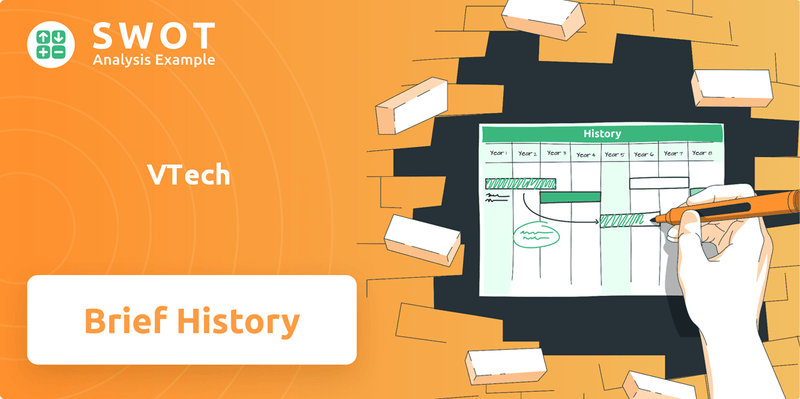
This VTech SWOT Analysis reveals how this company transformed from a startup with a US$40,000 investment into a multinational corporation. With a 2025 group revenue of US$2.17 billion, VTech has solidified its position as the number one US cordless phone brand and a leading manufacturer of VTech toys, demonstrating a remarkable VTech timeline of growth and market leadership. Explore the brief history of VTech to discover its significant milestones, product evolution, and the factors behind its enduring success in the competitive electronics market.
What is the VTech Founding Story?
The story of the company, now a global leader in electronic learning products, began in Hong Kong in October 1976. The company's journey started with a vision to capitalize on the emerging technology of microprocessors.
Founded by Allan Wong and Stephen Leung, the company's early focus was on video games. With an initial investment and a small team, they set out to make their mark in the burgeoning consumer electronics market. This marked the beginning of what would become a significant player in the tech industry.
Allan Wong, an electrical engineer, and Stephen Leung launched the company in Hong Kong in 1976.
- The initial investment was approximately US$40,000.
- The first product was a home TV game console, a version of 'Pong,' launched in 1977.
- The company's initial focus was on the North American and European markets.
- Initially named 'Video Technology Limited,' the company's early focus was on video games.
Allan Wong, an electrical engineer with a master's degree, and Stephen Leung, saw an opportunity in the early 1970s with the advent of the Intel 4004 microprocessor. This led to the founding of the company in To Kwa Wan, Hong Kong. The initial team comprised about 40 employees. In its first year, the company's turnover was less than US$1 million. The company's first product was a home TV game console, a 'Pong' version, released in 1977. This product was primarily targeted at North American and European markets.
The company quickly expanded its operations, acting as an OEM for other brands. The name 'Video Technology Limited' reflected its initial focus on video games. The company's early funding likely came from bootstrapping or from friends and family, given the modest initial capital. The economic environment of Hong Kong in the 1970s, with its growing manufacturing capabilities and access to global markets, provided a favorable environment for the company to establish itself as an electronics company focused on exports.
The company's early success was built on its ability to identify and capitalize on emerging technological trends. This strategic foresight set the stage for its future growth and diversification into various product categories. Understanding the Competitors Landscape of VTech provides context for the company's early market positioning.
VTech SWOT Analysis
- Complete SWOT Breakdown
- Fully Customizable
- Editable in Excel & Word
- Professional Formatting
- Investor-Ready Format
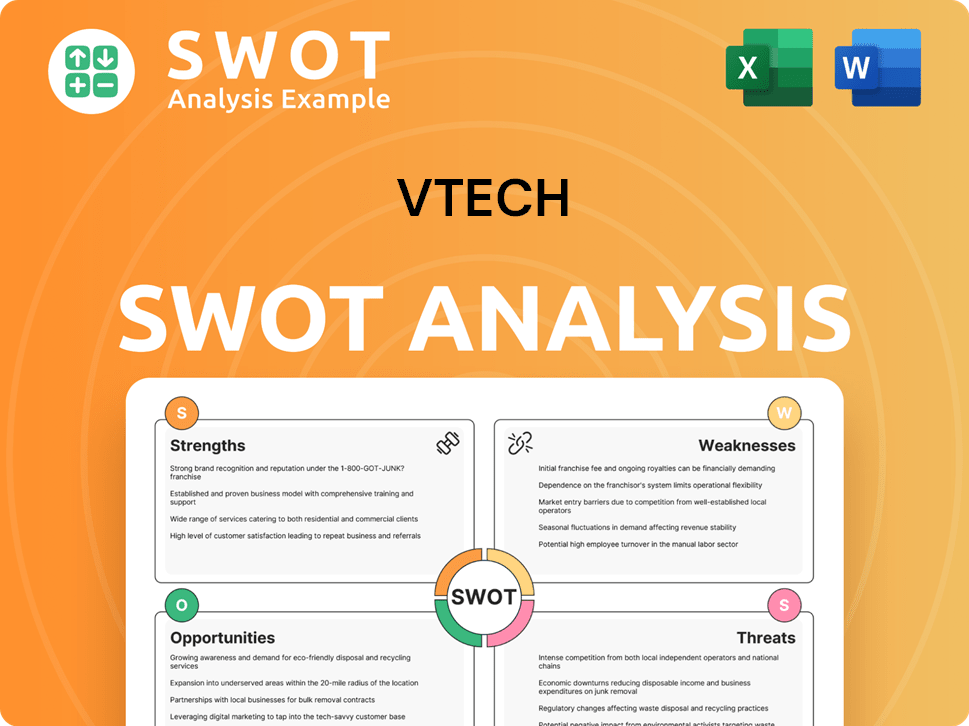
What Drove the Early Growth of VTech?
The early growth of the VTech company was characterized by rapid diversification and strategic geographical expansion. Following its initial success, VTech broadened its product range and established a strong presence in key markets. This expansion included the introduction of innovative products and the establishment of manufacturing capabilities.
After the success of its initial video game console, VTech launched its first electronic learning product (ELP), 'Lesson One,' at the New York Toy Fair in February 1980. This product, designed for basic spelling and math, was a significant milestone. An exclusive version called 'Computron' was offered to Sears, demonstrating early market recognition. The success of 'Lesson One' established VTech as a pioneer in the children's electronics sector, setting the stage for future VTech products.
In 1981, VTech introduced the CreatiVision, a computer-hybrid product, combining PC and video game console functionalities. This was followed by the Laser 100 series in 1983, a range of personal computers based on in-house designed custom integrated circuit (ASIC) chips. This diversification marked a shift from solely video games to a broader range of consumer electronics, particularly focusing on educational products and personal computers.
VTech expanded internationally by establishing its first sales subsidiary in the US in 1982, followed by a UK subsidiary in 1984. The company also ventured into contract manufacturing services (CMS) in 1984, producing satellite receivers for the US market. By the mid-1980s, VTech had become the largest supplier of electronic learning aids in the US, showcasing its strong market share.
Allan Wong remained as Chairman and Group CEO during this period of growth. The company was first listed in Hong Kong in June 1986 under the name 'Video Technology International (Holdings) Limited.' This listing marked a significant step in the company's financial history, allowing for further expansion and investment. The strategic shift and market reception were positive, with products like 'Lesson One' becoming bestsellers.
VTech PESTLE Analysis
- Covers All 6 PESTLE Categories
- No Research Needed – Save Hours of Work
- Built by Experts, Trusted by Consultants
- Instant Download, Ready to Use
- 100% Editable, Fully Customizable
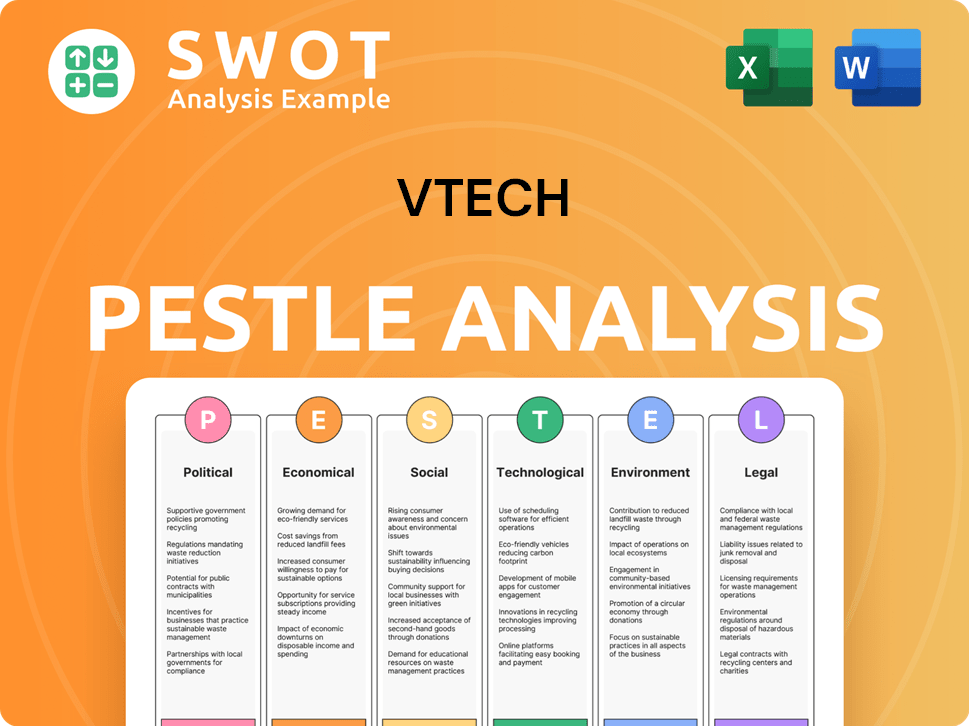
What are the key Milestones in VTech history?
The VTech company has seen numerous significant milestones throughout its history, from pioneering telecommunications to leading in electronic learning products. These achievements highlight the company's evolution and its ability to adapt to market changes, establishing its place in both the telecommunications and electronic learning sectors.
| Year | Milestone |
|---|---|
| 1991 | Introduced the world's first 900 MHz cordless phone, marking a significant advancement in telecommunications. |
| 2002 | Launched the first 5.8 GHz cordless phone, further solidifying its position in the cordless phone market. |
| 2004 | Introduced the V.Smile TV Learning System, expanding its presence in the electronic learning product industry. |
| 2005 | Developed the first integrated VoIP cordless phone, showcasing innovation in voice over IP technology. |
| 2018, 2020 | Established manufacturing facilities in Malaysia, reflecting a strategic move in response to evolving tariff situations. |
| 2021 | Established a manufacturing facility in Mexico, further diversifying its global manufacturing footprint. |
| September 2023 | Launched the V-Care VC2105 Smart Baby Monitor, integrating AI for sleep analytics and real-time alerts. |
| 2024 | Acquired Gigaset and established a manufacturing facility in Germany, strengthening its telecommunication product offerings in Europe. |
| FY2025 | VTech CMS won six supplier awards in Europe, demonstrating its strong performance and recognition in the industry. |
VTech has consistently demonstrated innovation in its product development, particularly in telecommunications and electronic learning. The company's early adoption of new technologies, such as VoIP and AI-driven baby monitors, showcases its commitment to staying at the forefront of technological advancements.
VTech was among the first to introduce cordless phones, including the 900 MHz and 5.8 GHz models, revolutionizing home and office communication. These innovations helped establish VTech as a key player in the telecommunications market, offering greater mobility and convenience.
The development of the first integrated VoIP cordless phone demonstrated VTech's forward-thinking approach. This technology allowed for seamless integration of traditional phone lines with internet-based calling, preparing the company for the future of telecommunications.
VTech pioneered the electronic learning product industry, with products like the V.Smile TV Learning System, providing educational content in an engaging format. This initiative expanded the company's reach into the educational market, making learning fun for children.
The V-Care VC2105 Smart Baby Monitor, launched in September 2023, utilizes AI for sleep analytics and real-time alerts, demonstrating VTech's commitment to leveraging advanced technology. This product enhances the company's presence in the smart home market, offering innovative solutions for parents.
VTech's Marble Rush Storage Box won the 'Best Toy of the Year 2024' in the 'Construction' category, highlighting the company's success in the toy industry. This award underscores VTech's ability to create engaging and innovative toys that appeal to children.
VTech received the 'Trophée de l'innovation (Innovation Trophy) 2002-2023' from a key customer in France, recognizing its continuous innovation. This award highlights VTech's dedication to developing cutting-edge products and its strong relationships with its customers.
Despite its successes, VTech has faced challenges, including financial difficulties and market downturns. The company's ability to adapt and restructure its operations, along with strategic acquisitions and diversification, has been crucial to its long-term success.
In 2001, VTech experienced financial losses for the first time, leading to a profit warning and restructuring. These challenges highlighted the impact of market downturns and competitive pressures on the company's performance.
The acquisition of Lucent's telephone production unit in 2000 resulted in inventory issues, impacting VTech's financial stability. This acquisition highlighted the challenges of integrating new assets and managing operational complexities.
VTech responded to financial pressures by shutting down Lucent's plant in Mexico and consolidating production in mainland China. These strategic moves were essential for streamlining operations and improving profitability.
VTech faced challenges from market downturns and increased competition, requiring the company to adapt its strategies. These external factors underscored the need for constant innovation and market responsiveness.
In response to evolving tariff situations, VTech diversified its manufacturing footprint by establishing facilities in Malaysia, Mexico, and Germany. This strategic move enhanced the company's resilience and adaptability to global economic shifts.
The integration of Gigaset, completed on April 5, 2024, increased operating expenses in FY2025, though it is a key strategic move to boost sales in Europe. This highlights the complexities of large-scale acquisitions and their impact on financial performance.
VTech Business Model Canvas
- Complete 9-Block Business Model Canvas
- Effortlessly Communicate Your Business Strategy
- Investor-Ready BMC Format
- 100% Editable and Customizable
- Clear and Structured Layout
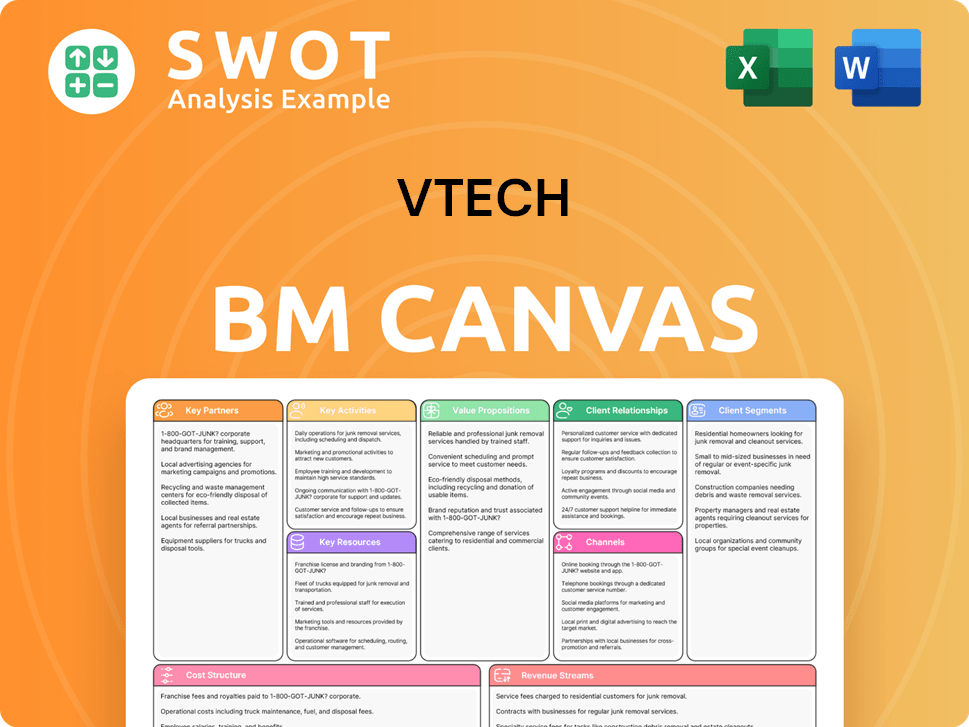
What is the Timeline of Key Events for VTech?
The VTech company has a rich history, marked by significant milestones and innovations in the consumer electronics market. From its beginnings in Hong Kong to its global presence today, VTech has consistently adapted to changing market demands. The company's evolution includes pioneering electronic learning products, entering the telecommunications sector, and expanding its manufacturing capabilities worldwide. This brief history of VTech highlights key moments that have shaped the company's trajectory and its impact on the industry.
| Year | Key Event |
|---|---|
| 1976 | VTech is founded in Hong Kong as Video Technology Limited, marking the start of its journey. |
| 1978 | VTech launches its first portable LED game, expanding its early product offerings. |
| 1980 | The company introduces 'Lesson One,' its first electronic learning product, at the New York Toy Fair. |
| 1986 | VTech is listed in Hong Kong as 'Video Technology International (Holdings) Limited,' a significant step in its corporate development. |
| 1991 | VTech is renamed VTech Holdings Limited and introduces the world's first 900 MHz cordless phone, showcasing its innovation in telecommunications. |
| 2000 | VTech acquires Lucent's telephone production unit and rights to the AT&T brand name, boosting its presence in the telecommunications market. |
| 2004 | The company launches the V.Smile game console, a key product in its educational toys segment. |
| 2016 | VTech acquires LeapFrog Enterprises, Inc., strengthening its position in the electronic learning products market. |
| 2018 | VTech opens its first manufacturing facility outside China in Muar, Malaysia, expanding its global footprint. |
| 2021 | VTech acquires an additional manufacturing facility in Tecate, Mexico, increasing its production capacity. |
| 2023 | VTech launches the V-Care VC2105 Smart Baby Monitor with AI features, demonstrating its commitment to innovation. |
| 2024 | VTech acquires the assets of Gigaset Communications GmbH, expanding its manufacturing to Germany. |
VTech's future strategy emphasizes continued product innovation, aiming to introduce new and improved VTech products. The company also aims to gain market share across its various product segments. This includes both expanding existing product lines and developing new offerings to meet evolving consumer demands. The company's focus is on maintaining a competitive edge in the market.
Geographical expansion remains a key focus for VTech, with plans to grow its presence in various international markets. The integration of Gigaset is a critical component of this strategy, particularly in Europe, where the company aims to revitalize sales of residential phones. VTech is also looking to expand the global manufacturing footprint.
VTech is committed to operational excellence, focusing on streamlining its manufacturing processes and improving efficiency. The company is assessing the implementation of Industry 4.0 in its Malaysian and Mexican facilities. Full turnkey electronics manufacturing services (EMS) capability from its Mexico factory is planned by June 2024, enhancing its service offerings.
The financial outlook for VTech is positive, with expectations of higher revenue in fiscal year 2025. This growth is anticipated due to the Gigaset integration and the launch of new VTech products. Improved profitability is also expected, supported by stable costs and a favorable product mix. The company's strategic initiatives are designed to drive sustainable growth.
VTech Porter's Five Forces Analysis
- Covers All 5 Competitive Forces in Detail
- Structured for Consultants, Students, and Founders
- 100% Editable in Microsoft Word & Excel
- Instant Digital Download – Use Immediately
- Compatible with Mac & PC – Fully Unlocked
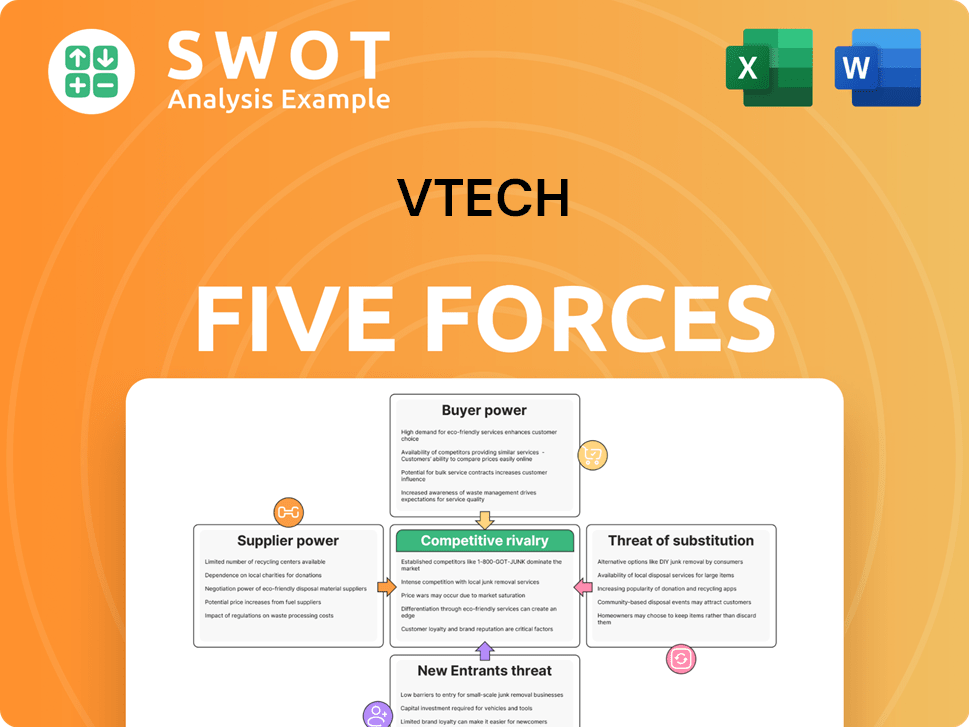
Related Blogs
- What is Competitive Landscape of VTech Company?
- What is Growth Strategy and Future Prospects of VTech Company?
- How Does VTech Company Work?
- What is Sales and Marketing Strategy of VTech Company?
- What is Brief History of VTech Company?
- Who Owns VTech Company?
- What is Customer Demographics and Target Market of VTech Company?
Disclaimer
All information, articles, and product details provided on this website are for general informational and educational purposes only. We do not claim any ownership over, nor do we intend to infringe upon, any trademarks, copyrights, logos, brand names, or other intellectual property mentioned or depicted on this site. Such intellectual property remains the property of its respective owners, and any references here are made solely for identification or informational purposes, without implying any affiliation, endorsement, or partnership.
We make no representations or warranties, express or implied, regarding the accuracy, completeness, or suitability of any content or products presented. Nothing on this website should be construed as legal, tax, investment, financial, medical, or other professional advice. In addition, no part of this site—including articles or product references—constitutes a solicitation, recommendation, endorsement, advertisement, or offer to buy or sell any securities, franchises, or other financial instruments, particularly in jurisdictions where such activity would be unlawful.
All content is of a general nature and may not address the specific circumstances of any individual or entity. It is not a substitute for professional advice or services. Any actions you take based on the information provided here are strictly at your own risk. You accept full responsibility for any decisions or outcomes arising from your use of this website and agree to release us from any liability in connection with your use of, or reliance upon, the content or products found herein.